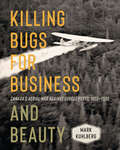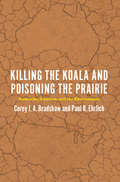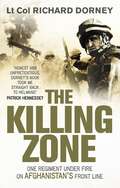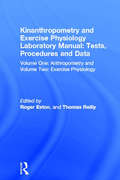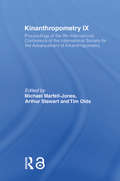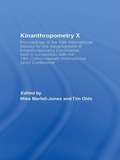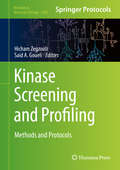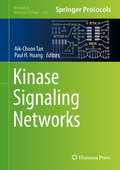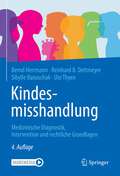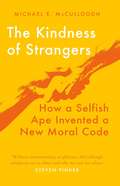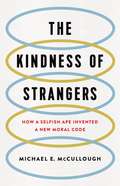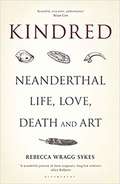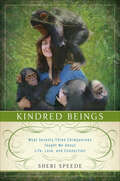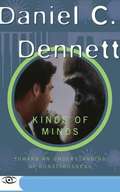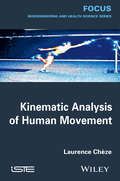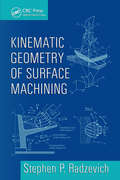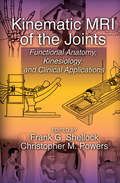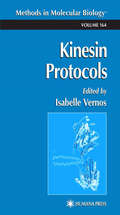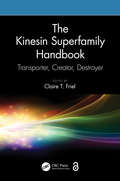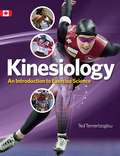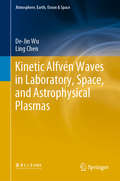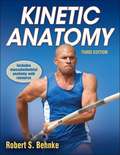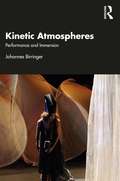- Table View
- List View
Killing Bugs for Business and Beauty: Canada’s Aerial War against Forest Pests, 1913–1930
by Mark KuhlbergKilling Bugs for Business and Beauty examines the beginning of Canada’s aerial war against forest insects and how a tiny handful of officials came to lead the world with a made-in-Canada solution to the problem. Shedding light on a largely forgotten chapter in Canadian environmental history, Mark Kuhlberg explores the theme of nature and its agency. The book highlights the shared impulses that often drove both the harvesters and the preservers of trees, and the acute dangers inherent in allowing emotional appeals instead of logic to drive environmental policy-making. It addresses both inter-governmental and intra-governmental relations, as well as pressure politics and lobbying. Including fascinating tales from Cape Breton Island, Muskoka, and Stanley Park, Killing Bugs for Business and Beauty clearly demonstrates how class, region, and commercial interest intersected to determine the location and timing of aerial bombings. At the core of this book about killing bugs is a story, infused with innovation and heroism, of the various conflicts that complicate how we worship wilderness.
Killing the Koala and Poisoning the Prairie: Australia, America, and the Environment
by Corey J. A. Bradshaw Paul R. EhrlichThough separated by thousands of miles, the United States and Australia have much in common. Geographically both countries are expansive--the United States is the fourth largest in land mass and Australia the sixth--and both possess a vast amount of natural biodiversity. At the same time, both nations are on a crash course toward environmental destruction. Highly developed super consumers with enormous energy footprints and high rates of greenhouse-gas emissions, they are two of the biggest drivers of climate change per capita. As renowned ecologists Corey J. A. Bradshaw and Paul R. Ehrlich make clear in Killing the Koala and Poisoning the Prairie, both of these countries must confront the urgent question of how to stem this devastation and turn back from the brink. In this book, Bradshaw and Ehrlich provide a spirited exploration of the ways in which the United States and Australia can learn from their shared problems and combine their most successful solutions in order to find and develop new resources, lower energy consumption and waste, and grapple with the dynamic effects of climate change. Peppering the book with humor, irreverence, and extensive scientific knowledge, the authors examine how residents of both countries have irrevocably altered their natural environments, detailing the most pressing ecological issues of our time, including the continuing resource depletion caused by overpopulation. They then turn their discussion to the politics behind the failures of environmental policies in both nations and offer a blueprint for what must be dramatically changed to prevent worsening the environmental crisis. Although focused on two nations, Killing the Koala and Poisoning the Prairie clearly has global implications--the problems facing the United States and Australia are not theirs alone, and the solutions to come will benefit by being crafted in coalition. This book provides a vital opportunity to learn from both countries' leading environmental thinkers and to heed their call for a way forward together.
Killing the Koala and Poisoning the Prairie: Australia, America, and the Environment
by Corey J. Bradshaw Paul R. EhrlichThough separated by thousands of miles, the United States and Australia have much in common. Geographically both countries are expansive—the United States is the fourth largest in land mass and Australia the sixth—and both possess a vast amount of natural biodiversity. At the same time, both nations are on a crash course toward environmental destruction. Highly developed super consumers with enormous energy footprints and high rates of greenhouse-gas emissions, they are two of the biggest drivers of climate change per capita. As renowned ecologists Corey J. A. Bradshaw and Paul R. Ehrlich make clear in Killing the Koala and Poisoning the Prairie, both of these countries must confront the urgent question of how to stem this devastation and turn back from the brink. In this book, Bradshaw and Ehrlich provide a spirited exploration of the ways in which the United States and Australia can learn from their shared problems and combine their most successful solutions in order to find and develop new resources, lower energy consumption and waste, and grapple with the dynamic effects of climate change. Peppering the book with humor, irreverence, and extensive scientific knowledge, the authors examine how residents of both countries have irrevocably altered their natural environments, detailing the most pressing ecological issues of our time, including the continuing resource depletion caused by overpopulation. They then turn their discussion to the politics behind the failures of environmental policies in both nations and offer a blueprint for what must be dramatically changed to prevent worsening the environmental crisis. Although focused on two nations, Killing the Koala and Poisoning the Prairie clearly has global implications—the problems facing the United States and Australia are not theirs alone, and the solutions to come will benefit by being crafted in coalition. This book provides a vital opportunity to learn from both countries’ leading environmental thinkers and to heed their call for a way forward together.
The Killing Zone
by Richard DorneyOn a tour of duty in the Helmand River Valley, the Grenadier Guards faced the toughest challenge of their lives...Carrying out patrols in the most fiercely contested land in Afghanistan the Guards were under fire almost constantly. The summer of 2007 saw some of the most frequent and intense combat yet, beyond what anyone could have predicted. Based in isolated forward operating bases their nearest reinforcements were often miles away, down a track strewn with deadly roadside bombs. The Killing Zone is an action-packed and authentic insight into the real Afghanistan. This is what it’s like to deliberately draw fire on your own position so that your mates can escape an ambush, to experience the adrenaline rush of being the first in to clear a Taliban compound, and to rely on skill, loyalty and quick-thinking to survive in one of the most dangerous places on earth.
Kin: How We Came to Know Our Microbe Relatives
by John L. IngrahamBy unlocking the evolutionary information contained in cells, biologists have been able to construct the Tree of Life and show that its three main stems are dominated by microbes. Plants and animals constitute a small upper branch in one stem. Soon we may know how life began over 3.5 billion years ago. John Ingraham tells this story of discovery.
Kinanthropometry and Exercise Physiology Laboratory Manual: Exercise Physiology
by Thomas Reilly Roger EstonThis is a combined set of the two fully revised and updated manuals Kinanthropometry and Exercise Physiology Laboratory Manual: Tests, Procedures and Data. The in-depth analyses of anthropometry and exercise physiology are presented in one volume for the first time. Physiology and practical work is now a compulsory element of sports and exercise science. These texts have been developed as key resources for lecturers and students of kinanthropometry, sports science, human movement and exercise physiology. The well-illustrated manuals provide: * help in planning and conduct of practical sessions* comprehensive theoretical background on each topic and up-to-date information so that there is no need for additional reading* seven entirely new chapters providing a balance between kinanthropometry and physiology* eleven stand-alone chapters in each volume enabling the reader to pick out topics of interest in any order* a wide range of supporting diagrams, photographs and tables. A complete one-stop resource, this set presents laboratory procedures next to real-life practical examples, each supported with appropriate data. In addition, each chapter is supplemented by a complete review of contemporary literature, as well as theoretical overviews, offering an excellent basic introduction to each topic.
Kinanthropometry IX: Proceedings of the 9th International Conference of the International Society for the Advancement of Kinanthropometry
by Michael Marfell-Jones Arthur Stewart Tim OldsThis is an edited collection of peer-reviewed papers presented at the Ninth International Conference of the Society for the Advancement of Kinanthropometry. Defined as the relationship between human body structure and function, kinanthropometry is an area of growing interest, and these proceedings will be of use to students, academics and professionals in the areas of ergonomics, sports science, nutrition, health, and other allied fields. The assembled works represent the latest research findings across kinanthropometry, moving the discipline forward and promoting good practice and the exchange of expertise.
Kinanthropometry X: Proceedings of the 10th International Society for the Advancement of Kinanthropometry Conference, Held in Conjunction with the 13th Commonwealth International Sport Conference
by Mike Marfell-Jones Tim OldsThis book provides an up-to-date review of research and scientific knowledge in the field of kinanthropometry. This subject area is defined as the relationship between human structure and function and is exemplified in studies of growth and development, ergonomics, nutrition, human performance and health, among other applications. This edited collection includes the latest findings in kinanthropometric research and topics include body composition, athlete morphology and performance prediction, 3-dimensional analysis, body sizing, sexual dimorphism, virtual anthropometry, somatotype, bone density, body image and anthropometric pedagogy. Kinanthropometry X offers essential reading for students, academics and researchers in exercise science, kinanthropometry, physical education and human sciences.
Kinase Screening and Profiling
by Hicham Zegzouti Said A. GoueliThis volume focuses on screening and profiling kinase inhibitors or activators. Chapters in this book cover several facets of the drug discovery processes starting with target identification, and assay development and screening chemical libraries for hit identification and lead optimization. The profiling portion of Kinase Screening and Profiling: Methods and Protocols discusses several strategies and techniques that are required to minimize off target hits and reduce cellular toxicities that are caused by liability kinases. Written in the highly successful Methods in Molecular Biology series format, chapters include introductions to their respective topics, lists of the necessary materials and reagents, step-by-step, readily reproducible laboratory protocols, and tips on troubleshooting and avoiding known pitfalls. Timely and authoritative, Kinase Screening and Profiling: Methods and Protocols, will benefit scientists and researchers who are interested in exploring the role of kinases in academic, as well as pharmaceutical research.
Kinase Signaling Networks
by Aik-Choon Tan Paul H. HuangThis detailed volume describes cutting-edge techniques in three distinct and complementary areas of contemporary kinase biology research. Beginning with a section on synthetic biology, chemical biology, and screening approaches to kinase signaling networks, the book continues with sections on mass spectrometry and metabolic analysis of kinase signaling as well as computational analysis of kinase signaling networks. Written for the highly successful Methods in Molecular Biology series, chapters include introductions to their respective topics, lists of the necessary materials and reagents, step-by-step, readily reproducible laboratory protocols, and tips on troubleshooting and avoiding known pitfalls. Authoritative and practical, Kinase Signaling Networks aims to provide scientists with the tools necessary to overcome the technological bottlenecks that limit our ability to gain a deeper mechanistic understanding of kinase biology.
Kindesmisshandlung: Medizinische Diagnostik, Intervention und rechtliche Grundlagen
by Bernd Herrmann Reinhard B. Dettmeyer Sibylle Banaschak Ute ThyenDas bewährte Fachbuch zum Kinderschutz in der Medizin bietet Strategien für den Umgang mit Verdachtsfällen von Kindesmisshandlung und -vernachlässigung, fundierte fachliche Grundlagen für die Diagnose, Sicherheit in Rechtsfragen und erprobte Konzepte für die Intervention. Fundierte somatische Diagnostik Leitliniengerecht, hohe EvidenzRationale diagnostische StrategienForensische BefundsicherungKinder- und jugendgynäkologische Grundlagen Umsichtige Intervention & Prävention Gesprächsführung mit Eltern, Kindern und JugendlichenInterdisziplinäre Netzwerke schaffen und nutzenFrühe Hilfen und KinderschutzSchutzkonzepte für den Umgang mit Missbrauch in Institutionen Gesellschaftliche und rechtliche Grundlagen Auszüge wichtigster GesetzeGesetzlicher Opferschutz, psychosoziale Folgen Kompakt und praxisrelevant Korrekte Anamnese und DokumentationMerkblätter, Checklisten, InternetadressenPraxistipps, Differenzialdiagnosen und Fallstricke Vom „unguten Gefühl“ zu evidenzbasiertem Handeln. Unter Berücksichtigung der aktuellen Literatur, Gesetze und Rechtsprechung sowie der neuen nationalen AWMF S3+ Kinderschutzleitlinie und internationaler Leitlinien. Das erste deutschsprachige Handbuch für fachgerechte medizinische Diagnostik und Intervention. Das notwendige „Handwerkszeug“ für Ärzte und andere Gesundheitsberufe, um in der täglichen Praxis die richtigen Entscheidungen zu treffen. Als bewährter Leitfaden, Ratgeber und Nachschlagewerk für Ärzte, aber auch alle anderen beteiligten Fachleute im Kinderschutz: Juristen, Polizei, Jugendämter, Beratungsstellen. Mit allen relevanten Inhalten für Basis- und Aufbaukurs des Zertifikatslehrganges Kinderschutzmedizin der Deutschen Gesellschaft für Kinderschutz in der Medizin (DGKiM).Mit eLernkarten „Flashcards“ zur Vorbereitung auf die Zertifikatsprüfung Kinderschutzmedizin der DGKiM.
The Kindness of Strangers: How a Selfish Ape Invented a New Moral Code
by Michael E. McCulloughWhy do we give a damn about strangers? Altruism is unique to the human species. It is also one of the great evolutionary puzzles, and we may be on the brink of solving it. It turns out that, over the last 12,000 years, we have become more and more altruistic. This is despite the fact that, the majority of the time, our minds are still breathtakingly indifferent to the welfare of others. In solving the enigma of generosity in a world of strangers, McCullough takes us on a sweeping history of society and science to warn that, if we are not careful, our instincts and sympathies have as much potential for harm as for good. The bad news is that we are not designed to be kind. The good news is that we can push ourselves to be kind anyway, together.
The Kindness of Strangers: How a Selfish Ape Invented a New Moral Code
by Michael E. McCulloughA sweeping psychological history of human goodness -- from the foundations of evolution to the modern political and social challenges humanity is now facing. How did humans, a species of self-centered apes, come to care about others? Since Darwin, scientists have tried to answer this question using evolutionary theory. In The Kindness of Strangers, psychologist Michael E. McCullough shows why they have failed and offers a new explanation instead. From the moment nomadic humans first settled down until the aftermath of the Second World War, our species has confronted repeated crises that we could only survive by changing our behavior. As McCullough argues, these choices weren't enabled by an evolved moral sense, but with moral invention -- driven not by evolution's dictates but by reason. Today's challenges -- climate change, mass migration, nationalism -- are some of humanity's greatest yet. In revealing how past crises shaped the foundations of human concern, The Kindness of Strangers offers clues for how we can adapt our moral thinking to survive these challenges as well.
Kindred: Neanderthal Life, Love, Death and Art
by Rebecca Wragg SykesIn Kindred, Neanderthal expert Rebecca Wragg Sykes shoves aside the cliché of the shivering ragged figure in an icy wasteland, and reveals the Neanderthal you don’t know, our ancestor who lived across vast and diverse tracts of Eurasia and survived through hundreds of thousands of years of massive climate change. This book sheds new light on where they lived, what they ate, and the increasingly complex Neanderthal culture that researchers have discovered. <p><p> Since their discovery 150 years ago, Neanderthals have gone from the losers of the human family tree to A-list hominins. Our perception of the Neanderthal has changed dramatically, but despite growing scientific curiosity, popular culture fascination, and a wealth of coverage in the media and beyond are we getting the whole story? The reality of 21st century Neanderthals is complex and fascinating, yet remains virtually unknown and inaccessible outside the scientific literature. <p><p> Based on the author’s first-hand experience at the cutting-edge of Palaeolithic research and theory, this easy-to-read but information-rich book lays out the first full picture we have of the Neanderthals, from amazing new discoveries changing our view of them forever, to the more enduring mysteries of how they lived and died, and the biggest question of them all: their relationship with modern humans.
Kindred Beings: What Seventy-Three Chimpanzees Taught Me About Life, Love, and Connection
by Sheri SpeedeEnter a world of tender friendships, staunch loyalties, violent jealousies—and enduring love.As a child, Sheri Speede knew that she wanted to advocate for animals in any way she could. But it was not until many years after veterinary school, when she was transporting a chimpanzee named Pierre away from a biomedical facility as part of her job as a conservation advocate in Cameroon, that Dr. Speede discovered her true calling. She began to search for land for a forest sanctuary for captive chimpanzees that were held on chains and in small cages at local hotels.Dr. Speede eventually founded the Sanaga-Yong Chimpanzee Rescue Center, a forested home for orphans of the illegal ape meat trade. One chim- panzee, Dorothy, was rescued by Dr. Speede and her colleagues from a bleak existence imprisoned on a chain and forged a deep friendship with her. Dr. Speede explains how chimpanzees, like humans, are capable of a broad spectrum of emotional behaviors—both hateful and loving. Dr. Speede also candidly reveals her own struggles as a stranger in a foreign culture trying to adjust to rural African village life. And she admits that unlike Dorothy, she was not always kind, gentle, and forgiving.Dorothy died of old age at the sanctuary, and a photograph of Dorothy's funeral, in which Dr. Speede cradled Dorothy's head while her family of chimpanzees mournfully viewed her body, went viral after being published in National Geographic. The world was surprised at the depth of the chimps' grief at the loss of their friend, but Dr. Speede was not. Through the chimps, she had come to understand the meaning of love, loyalty, and true connection.While this is a compelling story about the emotional complexity of the chimpanzees she rescued and befriended, it is also Dr. Speede's story. Major events in her personal life, including love affairs, dangerous run-ins with criminals, and the birth of her daughter, unfold as the development of her primate rescue center runs parallel to her own development. Ultimately, Kindred Beings is a story of profound resilience, of both the apes and the woman who loved them.
Kinds of Minds: Toward an Understanding of Consciousness
by Daniel Clement DennettCombining ideas from philosophy, artificial intelligence, and neurobiology, Daniel Dennett leads the reader on a journey of inquiry, exploring such intriguing possibilities as: Can any of us really know what is going on in someone else's mind?
Kinematic Analysis of Human Movement
by Laurence Ch ZeAfter a quick survey of the famous pioneers of human movement analysis and the actual needs in different domains, this book presents the main types of systems available on the market (with the pros and cons), and then details the most widely used: the optoelectronic systems using passive markers. The theoretical background for joint kinematics calculation is explained, specifying the international standardization for parameters reports. One chapter is dedicated to measurement errors and their management, followed by several applications, mostly in the clinical field.
Kinematic Geometry of Surface Machining
by Stephen P. RadzevichThe principle of Occam's razor loosely translates tothe simplest solution is often the best. The author of Kinematic Geometry of Surface Machining utilizes this reductionist philosophy to provide a solution to the highly inefficient process of machining sculptured parts on multi-axis NC machines. He has developed a method to quickly calcu
Kinematic MRI of the Joints: Functional Anatomy, Kinesiology, and Clinical Applications
by Frank G. Shellock Christopher M. PowersKinematic MRI refers to imaging a joint through a range of motion to examine the interactions between the soft tissue and osseous anatomy that comprise the joint. Kinematic MRI techniques were developed because various pathologic conditions are dependent on the specific position of the joint or in response to loading or stress. Importantly, static-
Kinesin Protocols
by Isabelle VernosIsabelle Vernos and a panel of hands-on experts present their most productive and reproducible techniques for the identification, purification, and characterization of the kinesin superfamily of microtubule-dependent motors. The methods range from the most basic to the most sophisticated and include step-by-step instructions and extensive cautionary notes to ensure experimental success. Among the approaches considered are methods to express and purify kinesins in different systems, to characterize microtubule-enhanced ATPase activity and motility properties, and to test microtubule destabilizing activity. Comprehensive and highly practical, Kinesin Protocols makes available all the key basic and cutting-edge methods needed to successfully study the multifaceted world of kinesin-like proteins and to explore their many functions.
The Kinesin Superfamily Handbook: Transporter, Creator, Destroyer
by Claire T. FrielThis book brings together current information on the families that make up the kinesin superfamily of molecular motors in one comprehensive text; an ideal reference for researchers looking to make comparisons between different families, for specific information on an individual family, or simply for an overview of the kinesin superfamily.Information is clearly structured and grouped according to individual families and organised in a standardised way, allowing the reader to easily search and retrieve information on this large superfamily of molecular motors and understand how its individual members carry out a diverse variety of cellular functions. Features: The first book dedicated to the entire kinesin superfamily Enables a fuller understanding of this family of proteins, which is becoming an increasing focus of research due to its involvement in diseases such as cancer, neuropathies and ciliopathies. Written in a manner accessible to a range of researchers in the life and medical sciences, including biophysicists, biochemists and medical researchers. Chapter 4 of this book is freely available as a downloadable Open Access PDF under a Creative Commons Attribution-Non Commercial-No Derivatives 4.0 license. Chapter 11 of this book is freely available as a downloadable Open Access PDF under a Creative Commons Attribution-Non Commercial-No Derivatives 4.0 license.
Kinesiology: An Introduction to Exercise Science
by Ted TemertzoglouThe new Kinesiology goes beyond the curriculum, for a well-rounded understanding of the relevant concepts and issues. 45 special interest features will excite your students and stretch their imaginations. Features include: <p><p> Lifestyle Diseases <p> Gray’s Anatomy, 1858 <p> What Makes Usain Bolt Run <p> Long-Term Athlete Development <p> Yoga and Pilates
Kinetic Alfvén Waves in Laboratory, Space, and Astrophysical Plasmas (Atmosphere, Earth, Ocean & Space)
by Ling Chen De-Jin WuThis book provides a systematic introduction to the observation and application of kinetic Alfven waves (KAWs) in various plasma environments, with a special focus on the solar-terrestrial coupling system. Alfven waves are low-frequency and long-wavelength fluctuations that pervade laboratory, space and cosmic plasmas. KAWs are dispersive Alfven waves with a short wavelength comparable to particle kinematic scales and hence can play important roles in the energization and transport of plasma particles, the formation of fine magneto-plasma structures, and the dissipation of turbulent Alfven waves.Since the 1990s, experimental studies on KAWs in laboratory and space plasmas have significantly advanced our understanding of KAWs, making them an increasingly interesting subject. Without a doubt, the solar–terrestrial coupling system provides us with a unique natural laboratory for the comprehensive study of KAWs. This book presents extensive observations of KAWs in solar and heliospheric plasmas, as well as numerous applications of KAWs in the solar-terrestrial coupling system, including solar atmosphere heating, solarwind turbulence, solar wind-magnetosphere interactions, and magnetosphere-ionosphere coupling. In addition, for the sake of consistency, the book includes the basic theories and physical properties of KAWs, as well as their experimental demonstrations in laboratory plasmas. In closing, it discusses possible applications of KAWs to other astrophysical plasmas. Accordingly, the book covers all the major aspects of KAWs in a coherent manner that will appeal to advanced graduate students and researchers whose work involves laboratory, space and astrophysical plasmas.
Kinetic Anatomy (Third Edition)
by Robert BehnkeCreated primarily for those who will work in physical activity fields, the third edition of Kinetic Anatomy continues to building on its previous editions to assert itself as the ideal resource for learning structural anatomy and how it affects movement. The text gives students a firm concept of musculoskeletal anatomy by systematically assembling each component of the human body. Layer by layer, readers will study bones, ligaments, joints, and muscles on the bones, as well as the nerves and blood vessels that supply these muscles that are essential for movement. Kinetic Anatomy, Third Edition, includes coverage of three major structures that are not often considered when studying the anatomy of movement: the brain, heart, and lungs. As the centerpieces for the nervous, cardiovascular, and respiratory systems, these structures are essential to human movement and are highlighted throughout the text where appropriate. In addition, other fundamental features make this resource a valuable tool for learning and teaching human anatomy: - A one-year subscription to Musculoskeletal Anatomy Review, an online anatomy program, provides an interactive forum for reviewing regional structural anatomy. - A new chapter on the head completes the regional approach followed in the text. - More information on muscle and motor units helps broaden information on movement potential in selected sport activities. - Expanded discussion on joint strength and movement and the function of muscles (agonists, antagonists, stabilizers, and synergists), levers, and exercise supports understanding of how the human body is constructed. - Full-color photos and illustrations enhance the learning experience. - New Functional Movement Exercises provide students with the opportunity for practical application of their studies by asking them to identify the prime mover, antagonist, fixator, and synergist muscle in a particular movement. - Hands On exercises throughout the book offer students practice in physically identifying anatomical structures on themselves or on a partner. Included with each new text is a key code allowing students one-year access to the online anatomy program Musculoskeletal Anatomy Review. This engaging supplement to the text offers a regional review of structural anatomy with exceptionally detailed, high-quality graphic images--the majority provided by Primal Pictures. Students can mouse over muscles and click for muscle identification, and each chapter features a pretest and posttest evaluation to help students pinpoint knowledge gaps and test their retention. The pretest can be taken multiple times and is generated randomly so it will never be the same, but the posttest may be taken only once. Test results can be printed and turned in so instructors have the option to use the tests as a grading tool. To further facilitate learning, each chapter in the book concludes with a review of the key terms referred to in the chapter, suggested learning activities, and review questions in multiple-choice and fill-in-the-blank formats. The answers to the questions are provided at the end of the book. For instructors, a new image bank accompanies the updated instructor guide and test package to aid in delivering the course content. Kinetic Anatomy, Third Edition, is an outstanding introductory resource for those who plan to specialize in any field related to physical activity. Readers will learn what structures are involved in movement and how those structures should function, allowing them to identify problems and correct them to enhance physical activity.
Kinetic Atmospheres: Performance and Immersion
by Johannes BirringerThis book offers a sustained and deeply experiential pragmatic study of performance environments, here defined at unstable, emerging, and multisensational atmospheres, open to interactions and travels in augmented virtualities. Birringer’s writings challenge common assumptions about embodiment and the digital, exploring and refining artistic research into physical movement behavior, gesture, sensing perception, cognition, and trans-sensory hallucination. If landscapes are autobiographical, and atmospheres prompt us to enter blurred lines of a "forest knowledge," where light, shade, and darkness entangle us in foraging mediations of contaminated diversity, then such sensitization to elemental environments requires a focus on processual interaction. Provocative chapters probe various types of performance scenarios and immersive architectures of the real and the virtual. They break new ground in analyzing an extended choreographic – the building of hypersensorial scenographies that include a range of materialities as well as bodily and metabodily presences. Foregrounding his notion of kinetic atmospheres, the author intimates a technosomatic theory of dance, performance, and ritual processes, while engaging in a vivid cross-cultural dialogue with some of the leading digital and theatrical artists worldwide. This poetic meditation will be of great interest to students and scholars in theatre, performing arts as well as media arts practitioners, composers, programmers, and designers.
